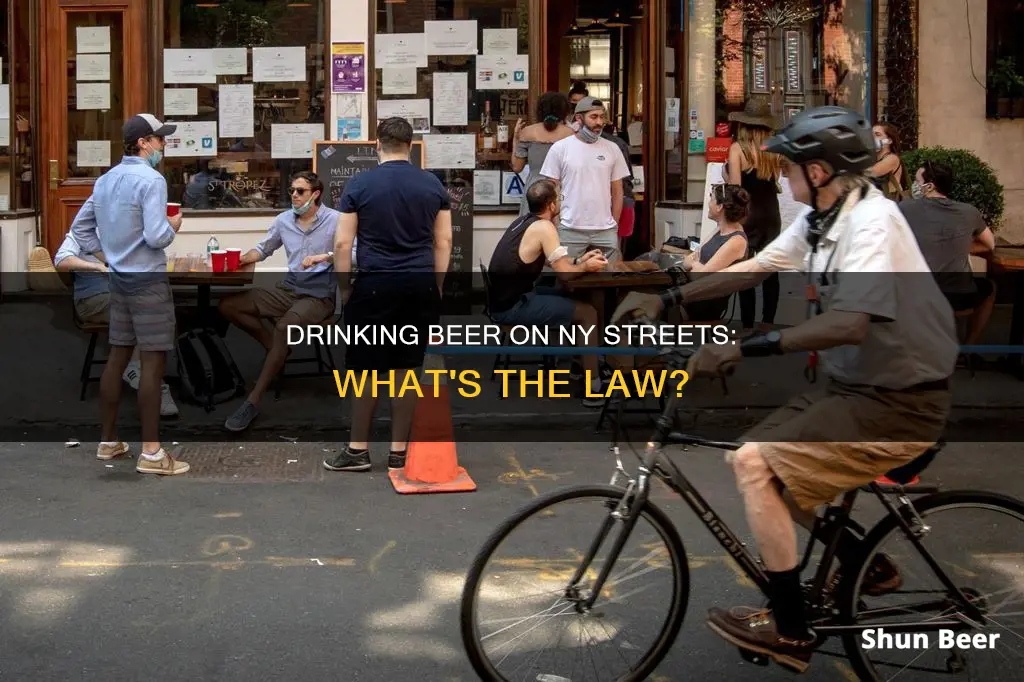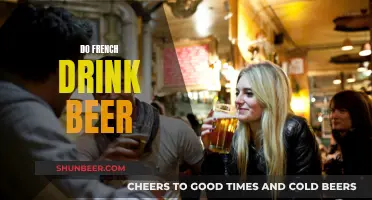
Drinking in public in New York City is prohibited. The law, which was introduced in 1979, applies to alcoholic beverages containing more than one-half of one percent of alcohol by volume. This means that drinking beer on the street in New York is illegal. However, there are some exceptions, such as during a block party, feast, or similar function for which a permit has been obtained. The fine for violating this law is $25, and it is not considered a crime. While the law is in place, its enforcement varies, and some people may be more likely to be targeted than others.
| Characteristics | Values |
|---|---|
| Drinking alcohol on the street | Prohibited |
| Drinking alcohol in parks | Prohibited |
| Drinking alcohol in public | Prohibited since 1979 |
| Punishment for drinking alcohol in public | A fine of up to $25 or imprisonment of up to one day |
| Open containers | Prohibited |
| Drinking alcohol in a vehicle | Prohibited |
| Drinking age | 21 |
What You'll Learn
- Drinking in public was outlawed in New York City in 1979
- Drinking alcohol on the street is a non-criminal offence
- An open container of alcohol in public creates a rebuttable presumption of intent to consume
- Drinking alcohol in public parks is prohibited
- Drinking in public is more acceptable for some than others

Drinking in public was outlawed in New York City in 1979
The law prohibits the drinking of alcoholic beverages on the streets of New York City, as well as the possession of open containers of alcoholic drinks in public places, including streets, playgrounds, shopping centres, subway stations, and parks. Those found in violation of the law can be fined up to $25, imprisoned for up to five days, or both.
The law was approved by the City Council, 31 to 7, and it went into effect soon after. Similar laws had been passed before, such as the Raines Law of 1896, which raised the cost of an annual liquor license, prohibited the sale of alcohol within 200 feet of a church or school, and banned Sunday alcohol sales (except in hotels). However, this law was largely unenforced, and saloons found creative ways to get around it, such as by creating cheap, inedible sandwiches that allowed them to exploit a loophole in the law.
Despite the law, drinking in public continues to occur in New York City, and some have treated the city's temporary takeout-cocktail laws as a cause for celebration. In 2016, drinking in public in Manhattan was decriminalised, although NYPD officers may still arrest intoxicated individuals on other charges.
Beer Drinking: Cold or Not?
You may want to see also

Drinking alcohol on the street is a non-criminal offence
Drinking alcohol on the street in New York is a non-criminal offence, but it is prohibited. This means that while you may be fined or even imprisoned for a day, it is not a crime and will not result in a criminal record.
The law, which was introduced by Ed Koch in 1979, states that "no person shall drink or consume an alcoholic beverage, or possess, with intent to drink or consume, an open container containing an alcoholic beverage in any public place". This includes streets, roads, sidewalks, parks and beaches. The only exception is if you are at a block party, feast or similar function for which a permit has been obtained.
The law was originally pitched as targeting antisocial behaviour, with one of its proponents, Frederick E. Samuel, stating: "We do not recklessly expect the police to give a summons to a Con Ed worker having a beer with his lunch".
However, the enforcement of this law has been criticised as being carried out in a hateful and racist manner, with some people able to drink in public without being policed, while others are worried about being attacked by police for standing outside.
While drinking alcohol in public is prohibited, there are ways to reduce the risk of being caught by the police. This includes drinking discreetly from unmarked cups or water bottles, rather than having open beer cans or wine bottles visible.
Strategizing My Career Path: Beer Distributor Experience
You may want to see also

An open container of alcohol in public creates a rebuttable presumption of intent to consume
In New York, drinking in public is a non-criminal offence. Alcohol laws in the state of New York are a set of laws specific to manufacturing, purchasing, serving, selling, and consuming alcohol. These laws, combined with federal and local laws, as well as vendor policies, determine the state's legal drinking age, driving under the influence limit, liquor license requirements, and more.
The New York State Liquor Authority (NYSLA) and its agency arm, the Division of Alcoholic Beverage Control (DABC), were established in 1934 to "regulate and control the manufacture and distribution within the state of alcoholic beverages for the purpose of fostering and promoting temperance in their consumption and respect for and obedience to law."
The NYSLA does not permit establishments to allow patrons to "B.Y.O.B." if the establishment does not have a license or permit to sell alcoholic beverages. The only exception to this rule is that establishments with fewer than 20 seats can permit B.Y.O.B.
The consumption of alcohol in public places within the unincorporated township is prohibited by Town Law. Possession of an open or partially consumed container of an alcoholic beverage creates a rebuttable presumption of intent to consume the beverage. This means that while possession of an open container does not automatically mean that the possessor intended to consume the alcohol, it can be assumed that this was the intention unless proven otherwise.
The penalty for a first offence is a fine of between $25 and $50. A second offence within three years is treated as a misdemeanour and carries a fine of between $100 and $250 and/or imprisonment for up to 15 days.
It is important to note that these laws may vary depending on the specific county or city within New York.
Beer and TURP Surgery: What You Need to Know
You may want to see also

Drinking alcohol in public parks is prohibited
Drinking alcohol in public parks in New York is prohibited. This is part of the city's open container laws, which ban the consumption of alcoholic beverages in public places. These laws were introduced in 1979 to prevent public drunkenness and antisocial behaviour.
The New York City Administrative Code defines a public place as:
> "A place to which the public or a substantial group of persons has access including, but not limited to, any highway, street, road, sidewalk, parking area, shopping area, place of amusement, playground, park or beach located within the city except that the definition of a public place shall not include those premises duly licensed for the sale and consumption of alcoholic beverages on the premises or within their own private property."
This means that drinking alcohol in a public park is illegal and can result in a fine of up to $25 or imprisonment of up to one day. The code also states that possession of an open container of alcohol creates a "rebuttable presumption" that the person intends to consume it, which can be used as grounds for a summons or arrest.
However, there are some exceptions to these laws. Drinking alcohol at a block party, feast, or similar function for which a permit has been obtained is allowed. Additionally, consumption of alcohol is permitted in duly licensed establishments with a certificate of occupancy that extends to the street.
Some people choose to discreetly drink alcohol in public parks by using unmarked cups or water bottles, as the police cannot test the contents of a container without probable cause. However, drinking games and open containers of alcohol will likely result in a citation or ticket.
It is important to note that the enforcement of these laws may vary, and individuals may still be at risk of receiving a summons or being arrested for drinking in a public park, even if they are not causing a disturbance.
Children and Non-Alcoholic Beer: Pub Rules Explained
You may want to see also

Drinking in public is more acceptable for some than others
Drinking in public is prohibited in New York City. The law states that:
> No person shall drink or consume an alcoholic beverage, or possess, with intent to drink or consume, an open container containing an alcoholic beverage in any public place except at a block party, feast or similar function for which a permit has been obtained.
However, it seems that this law is more acceptable for some than others. In a first-person account, Christian Rodriguez describes the differences between two neighbouring streets in Manhattan: Avenue D, where he grew up, and Avenue C. On Avenue D, there is a heavy police presence, businesses close early, and people move quickly. On Avenue C, by contrast, businesses are open late, and masses of people drink on the street without fear of being stopped by the police.
Rodriguez goes on to describe how, in his experience, the enforcement of public drinking laws is carried out in a hateful and racist manner. He notes that if you drink in a public space like Central Park, or on the sidewalk of your brownstone, you are less likely to be policed. This divide is further illustrated by an anecdote in which Rodriguez witnessed an act of police brutality on Avenue D, where two people were approached and asked to disperse, and a bystander who started recording the incident was punched and thrown to the ground by an officer.
In another example, a commenter on a TripAdvisor forum reports that they have seen people drinking wine and beer in Central Park in front of NYPD officers. This suggests that drinking in public is, in some cases, tacitly accepted by law enforcement.
In conclusion, while drinking in public is prohibited in New York City, the enforcement of this law appears to be inconsistent and biased. This inconsistency has led to a situation where drinking in public is more acceptable for some people than for others, depending on factors such as race and location.
Beer and Periods: Is It Safe to Drink?
You may want to see also
Frequently asked questions
No, drinking beer on the street of New York is not considered a crime, but it is illegal. It is a non-criminal offence.
The violation of this law is punishable by a fine of not more than $25 or imprisonment of up to one day.
An alcoholic beverage is defined as any liquid intended for human consumption containing more than one-half of one percent (.005) of alcohol by volume.







